-
Christmas inspiration
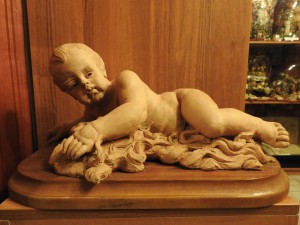 Thousands of baby Jesus statues begged for my attention during a visit at Il-Mużew tal-Bambini in Birkirkara. However, I felt mostly intrigued by a particular terracotta figure which looked completely different from the rest. Its face had captivatingly unique features and the rest of the body was very life like. Yet it was only when I met its creator, sculptor Chris Ebejer, that I understood its real value, since that baby Jesus was not just a statue but a singular work of art.
Thousands of baby Jesus statues begged for my attention during a visit at Il-Mużew tal-Bambini in Birkirkara. However, I felt mostly intrigued by a particular terracotta figure which looked completely different from the rest. Its face had captivatingly unique features and the rest of the body was very life like. Yet it was only when I met its creator, sculptor Chris Ebejer, that I understood its real value, since that baby Jesus was not just a statue but a singular work of art.“My baby Jesus creations are not popular statues that are meant for domestic use or simply to act as a representation of the son of God. They have an added value because they are sculptures and not just statues,” explained Chris when I met him at his studio in Mqabba.
“When I do such works, my aim is not only to reproduce the tenderness of a baby but also to relay an artistic style and a distinct message. Such art pieces are not restricted just to the Christmas season but they can be cherished all throughout the year due to their artistic significance.”
An unfinished terracotta sculpture of a toddler Jesus lay waiting on a workbench. I couldn’t help noticing some subtle facial similarities between this work and the other one that I had viewed before. I was curious to know whether a sculptor would have a specific image in mind of how Jesus should be represented.
“Before starting to work on something, an artist needs to have a vision of what he intends to create. One wouldn’t picture the exact image in mind but there would already be an idea of the shape, the composition, and the layout of the figure. Details will not be clear but each artist will subconsciously compose some particular features which are typical of his style.”
“I must say that the facial features of this figure were inspired by those of my nephew. When he was a baby and later on a toddler, I studied closely his facial characteristics in order to explore the difference that exists between such a young face and that of an adult. For example, I observed that a toddler’s forehead is large when compared to the rest of the face, the upper lip is usually protruding, the cheeks are chubby and the neck is fleshy.”
The sculpted figure of Jesus looked quite human and earthly and I wondered whether such work involved a spiritual process as well?
“Whenever I am creating a sculpture, my foremost thought is always art. I am not motivated by any religious intentions and I do not aspire to encourage faith or to have people praying in front of my work. I have to admit that the subject is irrelevant to me.”
Nonetheless, although creativity and originality are always his primary goals, Chris revealed that there is a limit on how much one can move out of the religious figures’ codified facial characteristics which our culture has learnt to decipher and expect.
“No one has any idea how Jesus actually looked like, neither as a baby or a child, nor as an adult. Indeed, both his face and the way in which he is represented have changed considerably along the centuries. The belief that some images such as the Veil of the Veronica and the Shroud of Turin could be historically authentic has influenced very much the present impression of Jesus’s face. Once such images are portrayed over and over again and are accepted by society, their characteristics become codified and this will help people to recognize immediately the figure of Jesus. Certainly, as an artist, there are ways and means of how to be creative when dealing with such a significant figure. However, one must know his limits so as not to come out with a profane work.”
In earlier times, when art could reach out to people more than books, especially due to widespread illiteracy, the Catholic Church often used symbols within artistic works to deliver its messages.
“There were various symbols that were portrayed with baby Jesus. In Botticelli’s artwork Madonna of the Pomegranate, Jesus is holding a pomegranate in representation of his suffering and resurrection. On the other hand, in the Madonna of the Carnation by Leonardo da Vinci, Jesus is reaching out to a carnation which is the symbol of Passion.”
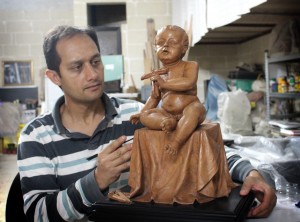 Chris pointed out to his sculpture of toddler Jesus where he had also included such symbols.
Chris pointed out to his sculpture of toddler Jesus where he had also included such symbols.“Although in this sculpture, Jesus might look just like any child, there are a number of clues which will hint to the viewer that there is more to it than that. In fact, the child in sitting on a humble box draped in cloth in allusion to when the babies of ancient royal families were placed on thrones. The young figure is holding a miniature cross in his hand and three nails lie down beneath him on the ground. All these objects, together with the boy’s meditative expression as he looks far out beyond his tender age, create an effect which suggests that the child is already seeing his mission for the future.”
As he continues with some final touches on this latest sculpture, Chris reveals that the autumn and wintery seasons tend to inspire him to create new works.
“I am deeply influenced by the change of seasons and by the transformation which they breed in the coloured landscape. Being from the rural village of Qrendi, I am very attracted to nature and my senses are intensely attuned to it. As the leaves start turning orangey red, melting in with the aroma of wet brown soil and the liquorish scent of carobs, I feel stimulated to think about Christmas and the birth and life of Jesus, and it is mainly during this period when I come up with new ideas for works with religious themes. Moreover, the earlier approach of night during these days entices me to stay more indoors and this provides me with much more time to work.”
A look at some of his finished works that were in his studio indicated that this sculptor had a particular preference to terracotta.
“I do love working with terracotta as besides being a natural medium, it also has a pleasant warm colour. It is also more fluid and softer to handle than other materials and so it allows me to work in greater tranquillity. The fact that terracotta has been in use since ancient times enhances also in me that sublime feeling that by utilising this medium, I am helping to keep this traditional technique alive.”
Apart from baby Jesus sculptures, during this season, Chris tends also to come out with new nativity creations.
“Tenderness and the love for the family are the main messages imbued in these works.”
(This article was published in Christmas Times magazine issued with The Times of Malta dated 8th December 2016)
-
It-traġedja tal-patrol boat
Kelmtejn qabel: Ktibt din il-ġrajja fl-1986, meta kelli 15 il-sena. Kienu għaddew sentejn mit-traġedja li laqtet lill-kuġinti Mary Farrugia fis-7 ta’ Settembru 1984, imma ż-żmien ftit li xejn kien taffa’ min-niket. Għaldaqstant kont qbadt pinna f’idi u ħażżiżt il-memorji tiegħi fuq il-karti sabiex b’hekk almenu moħħi u qalbi setgħu jistrieħu kemmxejn mit-toqol li din l-esperjenza kienet ħalliet fuqi wkoll. Għal xi raġuni ddeċidejt li nikteb il-ġrajja minn fomm kuġinti. Xejn minn dak li ktibt m’huwa mmaġinat għax dawn l-emozzjonijiet, il-ħsibijiet, u t-tifkiriet miktuba hawnhekk, smajthom u ġarrabthom flimkien magħha u ma’ wliedha. F’Diċembru 1987 iddeċidejt li nittajpja din il-kitba u bgħattha lill-bord editorjali tar-rivista Sagħtar sabiex jikkunsidrawha għall-pubblikazzjoni. Victor Fenech, wieħed mill-membri tal-bord editorjali, kien kitibli ittra sabiħa ferm fejn kien għarraffni kemm kienet qanqlitu din il-ġrajja. Eventwalment din ġiet ippubblikata fis-Sagħtar tal-ħarġa ta’ Frar 1987.
It-traġedja tal-patrol boat
Qomt daqsxejn kmieni aktar mis-soltu dakinhar peress li żewġi Twanny kellu jmur għax-xogħol. Ippreparajtlu daqsxejn ħobż, geżwirtulu f’karta, u poġġejtulu ġol-haversack ċkejken tiegħu.
Wara li libes il-ħwejjeġ tad-Dejma, inġabar flimkien miegħi mal-mejda biex nieħdu l-kolazzjon ta’ fil-għodu. Wara bies lit-tfal u hekk kif bies lili qalli li jekk idum daqsxejn ma jiġi, ma kelliex għalfejn ninkwieta peress li ma’ xi suldati oħra tad-Dejma kellu jmur jarmi xi murtali lejn Kemmuna. Kien għoddu ħareġ meta ftakar li kien nesa l-ġiżirana tad-deheb tiegħu. Magħha kellha mdendel salib kbir bi Kristu msallab fuqu. Kienet għal qalbu wisq dik il-ġiżirana u qatt ma kien jonqos milli jeħodha miegħu.
Qajjimt lit-tfal u tajthom jieklu u wara poġġejthom f’kamrithom biex jilgħabu daqsxejn sakemm jien innaddaf id-dar. Ma tantx stajt nitħabat peress li kont tqila bit-tielet tarbija tiegħi, iżda xi tfarfira ‘l hawn u ‘l hemm stajt nagħmilha faċilment.
Xi ftit ħin wara ġiet it-tifla ta’ ziti Fiona biex tgħini daqsxejn. Ħaslitli l-art u l-ħwejjeġ u b’hekk ħelsitni mix-xogħol iebes tiegħi. Qabel telqet wegħedtha li għal xil-5:00pm, x’ħin kellu jiġi Twanny, kellna neħduha magħna l-baħar. Sadanittant, biex ngħaddi ftit tal-ħin, qbadt żewġ ħbula u waħħalthom flimkien f’forma ta’ bandla bil-ħsieb illi la jiġi Twanny idendilha x’imkien fejn it-tfal ikunu jistgħu jitbandlu fuqha.
Għaddejt il-ħin tal-ġurnata bħas-soltu. Kienu saru xil-5:15pm meta smajt taħbita fuq il-bieb. Ħsibt li kien ġie Twanny iżda kienu xi zijiet tiegħi. Staqsewni jekk Twanny kienx irritorna d-dar. Għedtilhom li le u kollha ħarsu lejn xulxin b’ħarsa li tfisser ħafna. Għall-ewwel ma ndunajt b’xejn iżda meta bdew jiżdiedu aktar zijiet u nies li jiġu minni, bdejt nitħasseb. Fuq wiċċhom stajt naqralhom xi dulur jew biża’ li kien qiegħed inikkithom.
Saru s-7:00pm u kont għadni ma naf b’xejn. Josef, it-tifel il-kbir tiegħi ta 5 snin, beda jilgħab mar-radju sa ma xegħlu. Kienu bdew l-aħbarijiet. Ma tajtx każhom sakemm smajt xi kliem li ġibidli l-attenzjon tiegħi….
Spiċċaw il-punti ewlenin u l-qarrej beda jaqra l-aħbarijiet aktar fid-dettall. B’li smajt bqajt imbellha u msammra ma’ l-art! Qalbi bdiet tħabbat sitta sitta u ħassejtha trid tinqala’ minn postha bit-taħbit.
Xtaqt inwerżaq imma ma flaħtx. Ħassejt rasi ddur bija. Ma ridtx nemmen lil widnejja li Twanny tiegħi kien… mejjet. Il-lanċa li fuqha kien żewġi flimkien ma’ xi suldati oħra kienet splodiet! Wieħed kien salva, erbgħa oħra sabuhom mejtin u mtertqin f’wiċċ l-ilma, u t-tnejn l-oħra baqgħu ma nstabux.
Ġrejt lejn dar ommi biex inċempel lil dawk li kienu nkarigati. Kienu tawni aħbar li ħawditni. Ma kontx naf jekk kellix nittama jew nitbikkem: Twanny tiegħi kien wieħed minn dawk li ma nstabux.
“Imma tgħid salva?” staqsejt bejni u bejn ruħi. “Forsi kien iffortunat u salva. Mhux li kien! Imma jekk le? Alla tiegħi għinni għax ser niġġennen,” bdejt ngħid imbeżżgħa, imħawwda, u mbellha.
Xi wħud jaħsbu li t-tfal ma jifhmux xi jkun qed jiġri iżda dan mhu minnu xejn. Josef u Roderick, iż-żewġt itfal tiegħi, bdew jistaqsuni għal missierhom. Iż-żgħir ta’ sentejn beda jibki għax ried lil missieru ħdejh. Iżda l-aktar ħaġa li għaġġbitni kienet meta t-tifel żgħir ta’ ziti ta’ 4 snin resaq lejhom u qalilhom, “Għaliex qed tibku? Il-papà tagħkom miet għax waqa’ minn fuq id-dgħajsa. Issa ma jiġix għax miet.”
Għalkemm ma ridtx nemmen, ħassejt li dan it-tifel ċkejken kien qed jgħid il-verità.
Issa kien dalam sewwa u kulħadd qata’ qalbu milli għad jara lil Twanny ħaj. Kulħad inġabar lejn daru u raqqadt lil Fiona miegħi dakinhar biex teħodli ħsieb lit-tfal għax ma tantx kont qed inħossni fiha. Dakinhar ħadd ma seta’ jagħlaq għajn m’għajn u kull ħoss, anki l-iċken wieħed li beda jinstema’, bdejt nistħajjlu li żewġi ġie lura. Sa fl-aħħar moħħi ttaqqal bl-inkwiet u rqadt. Dħalt f’dinja ta’ ħolm ikreh liema bħalu; bdejt nara wiċċ żewġi mtertaq u mbiċċer b’ħarsa li twaħħax f’għajnejh.
Qomt mis-sodda mbeżżgħa u sibt li kienu xil-5:00am. Ma stajt norqod b’xejn u qgħdt inħares lejn iż-żewġ uliedi reqdin qishom xi żewġ anġli. “Il-kbir jixbħu wisq!” għedt f’qalbi. Xagħru safrani u għajnejh koħol kienu bħal ta’ missieru. Intbaħt li dakinhar ibni ma kellux dik it-tbissima fuq fommu bħas-soltu u minn ħin għall-ieħor kien isejjaħ, “Papà, papa`.”
Sejf ta’ dulur daħalli f’qalbi u f’dak il-ħin ftakart fit-tieġ tagħna. Kemm kont ħsibt li ser ngħaddi ħajja twila u ferħana miegħu. Għall-ħabta tas-6:00am qam kulħadd. Kull siegħa għaddejnieha nisimgħu l-aħbarijiet b’tama kbira iżda kien kollu għalxejn. Minn ħin għall-ieħor bdejt nirċievi telefonati mingħand niesi biex juruni s-sogħba tagħhom. Għal xil-11:00am irċevejt telefonata fejn għarrfuni li ġisem Twanny kien għadu ma nstabx. Qaluli wkoll li veru kellha tkun għalih il-mewt għax proprju dakinhar, hu ma kienx imissu jmur bil-murtali, imma kien ċeda lil ħabibu biex imur għall-festa. Twanny ma kien qalli xejn dwar dan għax kieku żgur li ma kontx inħallih imur.
Bqajna nittamaw għal bosta u bosta ġranet, imma kien kollu ta’ xejn. Kull lejl bdejt ngħaddih nibki u nħares lejn is-saqaf. It-tfal bdew iħossu aktar u aktar it-telfa ta’ missierhom! “Imma,” kont naħseb, “kemm nista’ ndum nigdbilhom? It-tfal qed jindunaw li ġara xi ħaġa lil missierhom.”
Iż-żmien itir bla ma biss tinduna u kollox jintesa miegħu. Hekk ukoll intesiet din it-traġedja iżda jien ma ninsiha qatt! Minn din il-ġrajja li ġrat sewwasew fis-7 ta’ Settembru 1984, għaddew sentejn…
Ma kinetx l-unika telfa tiegħi dik ta’ żewġi. Bix-xokk u l-qatgħa li ħadt, it-tarbija tiegħi twieldet qabel iż-żmien u tpoġġiet f’inkubatur. Semmejtu Anthony-Paul għal żewġi u għal missieri li kien miet xi ftit ġimgħat biss qabel Twanny. Ibni dam jilgħabha mal-mewt għal tliet ġimgħat, iżda hekk kif kien kważi rebaħ din il-battalja qalila, l-aħħar frott ta’ żewġi miet u mar jingħaqad flimkien ma’ missieru. Għadni niftakar li ma ridtx nemmen lil għajnejja hekk kif rajt lill-għażiż ibni mejjet! Ma ridtx nitilqu minn idejja. Kien qisu eżatt bambin ċkejken. Id-dmugħ qabiżli minn xfar għajnejja hekk kif missejtlu jdejh u xofftejh tarija u rqaq.
Kemm ħsibt li proprju b’dawk l-idejn għad imellisli wiċċi u proprju b’dawk ix-xufftejn għad isejjaħli, “Ma.” Iżda l-akbar għafsa ta’ qalb kienet meta firduli ‘l ibni minni u rajtu jgħib taħt it-trab għal dejjem! ….. Intlift minn sensija u ma nafx x’ġara aktar. Iżda meta stenbaħt sibt ruħi mdawwra b’uliedi, b’ommi, u b’zijieti.
Il-memorja bdiet tiġini f’moħħi bil-mod il-mod. Iva, issa rajt kollox ċar. Issa ma kien fadalli lil ebda wieħed minnhom. F’inqas minn xahrejn kont tlift lil missieri, lil żewġi u lil ibni. Bkejt kemm flaħt sakemm dmugħ iżjed xi nxerred ma baqgħalix.
Wara xi żmien, lil uliedi ħadthom iċ-ċimiterju biex isellmu lin-nannu u lil ħuhom. F’dik is-sikta tlabna flimkien għal ruħhom. F’qalbi kont qed nitlob għal ruħ żewġi wkoll. Kont mitlufa fi ħsibijieti meta ibni l-kbir reġa’ staqsieni l-istess mistoqsija li kien ilu jistaqsini għal bosta drabi, “Ma, bilħaqq il-papà għadu ma ġiex jara lil Anthony-Paul.”
“Il-papà jiġi, dalwaqt jiġi,” erġajt tennejtlu l-istess tweġiba li kont ilni ngħidlu għal sena sħiħa.
Dawwart wiċċi biex naħbi żewġ demgħat li ħarbuli minn għajnejja. Mur għidilhom lil uliedi li missierhom qiegħed jitlob għalihom mis-sema. Mur għidilhom li qatt u qatt m’hu ser jirritorna lura lejn id-dar! Tassew kienu tfal sfortunati aktar mill-oħrajn dawn uliedi għax lanqas ġisem missierhom ma nstab. F’jum il-missier, lanqas fjuri fuq qabru ma jistgħu jagħmlulu, għax ġismu qiegħed hemm, imtertaq taħt il-baħar, fis-skiet ta’ dejjem…..
-
Out of its shell
No one can really say what inspired Indrí Dimech known as Il-Mikk in 1898 to start decorating the façade of his property in Għaxaq with hundreds of snails and seashells which he collected from local and foreign beaches. However, some suggest that he might have seen such decorations when he was living abroad.
 Known to be able to do whatever came up to his mind, within two years, Indrí turned the two upper sides of the walls of his property in a huge canvas as he craftly designed them with religious symbols made out of snails and seashells. He embellished this artwork further by adding also three niches, a statue, and some writing which included his surname. Soon this property became renowned as Id-Dar tal-Bebbux (the house of snails).
Known to be able to do whatever came up to his mind, within two years, Indrí turned the two upper sides of the walls of his property in a huge canvas as he craftly designed them with religious symbols made out of snails and seashells. He embellished this artwork further by adding also three niches, a statue, and some writing which included his surname. Soon this property became renowned as Id-Dar tal-Bebbux (the house of snails).More than a century later, much of this unique artistic work has somehow succeeded to withstand the test of time. Yet considerable sections of it have been lost and what remains is in dire need of preservation and restoration. For many years, the Local Council of Għaxaq has been trying to obtain the necessary funds to save this singular property in St Mary Street but no one seems to be interested to protect this national cultural heritage.
“A recent application for funds in a scheme that was dedicated to the restoration of historical sites was disqualified since the work to restore Id-Dar Tal-Bebbux was going to take more than six months. Moreover, we were informed that there were no workers available in the Restoration Section who could do the type of work required for this property,” said Darren Abela, Mayor of the Għaxaq Local Council.
“We were all very disappointed to receive this news. It is deplorable to notice that it is always the same Local Councils who receive the funds to do restoration projects in their localities whilst our locality always ends up with nothing! Although we are in favour of such works, we find it difficult to understand why similar sites obtain the funds to be restored, whereas this property in Għaxaq which is unique, continues to be ignored.”
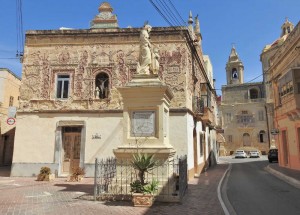 Abela insisted that about fifty years ago, this house was considered to be his village’s jewel while today, it is regarded as the village’s sorrow as it is painful to look at its pitiful state.
Abela insisted that about fifty years ago, this house was considered to be his village’s jewel while today, it is regarded as the village’s sorrow as it is painful to look at its pitiful state.“Everyone who sees this house or who hears about it recommends us to restore its old decorations before we lose them once and for all. And yet, nobody has ever came forward with any solid action to commence these works.”
No estimate of the value of the work required has ever been done because such a project requires particular expertise which till now was not located.
“At the moment, there are three different families living in this property and they have all agreed that this work should be done. I hope it won’t be too late if we’ll ever have the funds to start this project. It is already doubtful whether the snails and seashells which have fallen out could ever be replaced.”
It would definitely be a pity to allow further deterioration of this place. Indeed, Indrì Dimech’s work was deemed significant enough to be included in the National Inventory of the Cultural Property of the Maltese Islands where there is detailed information about the niches and the statues which form part of Id-Dar tal-Bebbux.
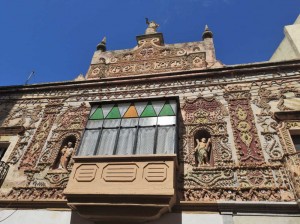 High up on the main facade which bears the date 1901, a small stone statue of the Virgin Mary, the patron saint of Għaxaq, stands triumphantly on a large sphere of clouds. Below it, on the left hand side, one can observe a niche with a stone statue of St Joseph holding baby Jesus; a saint which is also very cherished in this village and for whom a secondary feast is dedicated. On the right, another niche was constructed to contain the stone statue of St Andrew; the saint which has the same name as Indrì. Both these niches have been lavishly decorated with beautiful patterns made with snails and seashells and coloured with paint in between. Only the first three letters of the surname Dimech remain intact on the aperture of the left balcony, the middle balcony displays the letters C. Asciak, whilst the word Malta is still in one piece on the right balcony.
High up on the main facade which bears the date 1901, a small stone statue of the Virgin Mary, the patron saint of Għaxaq, stands triumphantly on a large sphere of clouds. Below it, on the left hand side, one can observe a niche with a stone statue of St Joseph holding baby Jesus; a saint which is also very cherished in this village and for whom a secondary feast is dedicated. On the right, another niche was constructed to contain the stone statue of St Andrew; the saint which has the same name as Indrì. Both these niches have been lavishly decorated with beautiful patterns made with snails and seashells and coloured with paint in between. Only the first three letters of the surname Dimech remain intact on the aperture of the left balcony, the middle balcony displays the letters C. Asciak, whilst the word Malta is still in one piece on the right balcony.Another niche with three stone statues showing a crucified figure of Christ accompanied by the Virgin Mary and St John the Evangelist claims the attention at the center of the other facade. Unfortunately, many of the shells which composed the intricate designs around this niche are now lost.
Several other designs which include religious symbols, particularly those connected to the Passion of the Christ, can also be recognized. A number of other forms show angels, crosses, palm trees, lions, unicorns, fountains, churches, Għaxaq’s coat of arms, and many others.
 Relatives of Indrì Dimech who often worked as a sailor in the Middle East narrated how he used to return from his voyages carrying numerous shells. Once back home in Għaxaq, he would cover the facade of his property with bedsheets and continue working on his masterpiece. It is not known whether these sheets served as a protection against the sun or whether he intended to surprise his neighbours once he was finished with his work.
Relatives of Indrì Dimech who often worked as a sailor in the Middle East narrated how he used to return from his voyages carrying numerous shells. Once back home in Għaxaq, he would cover the facade of his property with bedsheets and continue working on his masterpiece. It is not known whether these sheets served as a protection against the sun or whether he intended to surprise his neighbours once he was finished with his work.At the time, Indri’s property functioned as a bar wherein men gathered to have a drink and to socialize after a hard day’s work. In there, those who were devoted and passionate about the feast of St Mary met to discuss the events which had to be organized. Meanwhile, this place served also as the hub which sparked the idea of the establishment of the first social club in Għaxaq that was to be dedicated to the titular of the Assumption of Mary.
Even Indrì gave a helping hand to decorate the square that was located in front of his property during the feast. Numerous oil lamps and coloured paper turned the surrounding environment in a surreal atmosphere, especially with his bizarre property in the background.
Today, this property stands in the core of the village, just a few metres away from Għaxaq’s parish church. Although Indrì is gone, his aptitude to mesmerize still lingers on as passers by are captivated by the strange designs that he created. Hopefully, as soon as possible, the authorities would appreciate this gem for its uniqueness and would take the necessary actions to restore back its beauty and allure of bygone days.
(This article was published in the ‘Homes’ Supplement issued with The Sunday Times of Malta dated 3rd April 2016)
-
Safety at sea
Although the sea may be perceived as a barrier, in ancient times, when no infrastructure existed on land, it was actually the medium which connected one country to another. Travelling on the sea had its own risks and so eventually the idea of insuring a ship and its cargo developed. Traces of the first arrangements between merchants date back to the Roman Period, starting from contracts of sea loans and evolving through the centuries into more complex marine insurances.
Along their history, the Maltese Islands often formed part of important trade routes and therefore local merchants were soon involved in this sector of underwriting risks. A wealth of information related to this aspect is available in old documents which show the development of insurance that was offered against particular risks on the sea. Nonetheless, till now, the origins and progress of marine insurance in Malta have been given little attention.
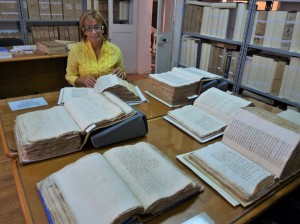 A visit to the Notarial Archives in Valletta where I met historian Dr Joan Abela introduced me to this interesting theme. Always ready to divulge enticing narratives from the valuable sources of these archives, Abela prepared for me a distinguished selection of thick manuscripts in order to help me explore the fine details available within.
A visit to the Notarial Archives in Valletta where I met historian Dr Joan Abela introduced me to this interesting theme. Always ready to divulge enticing narratives from the valuable sources of these archives, Abela prepared for me a distinguished selection of thick manuscripts in order to help me explore the fine details available within.“In antiquity, before marine insurance originated, a sea loan was the only means of transferring risks in maritime transport from the shipper to another person. This consisted of two partners, a traveling and a sedentary one, who pooled their capital in order to invest and share the risk together. With such an agreement, the travelling partner would have more money in hand to work with, whereas the sedentary one would be able to make a profit while staying on land to continue with his work and at the same time avoid the perils that existed out at sea,” explained Abela.
By the Late Middle Ages, as Italian merchants, particularly from Genoa, continued to experiment on these issues of securing vessels and their cargo, marine insurance gradually began to replace this type of agreement.
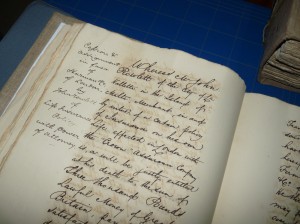 “Since marine insurance was still in its early stages of development, contracts did not adopt a uniform pattern, but varied considerably according to the exigencies of the contractors. Insurance contracts were usually categorized as Securitas by the notary, and were generally divided into two parts.”
“Since marine insurance was still in its early stages of development, contracts did not adopt a uniform pattern, but varied considerably according to the exigencies of the contractors. Insurance contracts were usually categorized as Securitas by the notary, and were generally divided into two parts.”“The first section listed the insurers’ names and the guaranteed premium which was calculated according to the routes, the prevailing conditions along these routes, the type of cargo, and also the type of ship being used. It also covered the kind of information which was regarded as essential for such a contract, that is, the name of the persons insured, specific details regarding the ship which was to undertake the venture, and other specifications regarding the merchandise and its destination. The second part of the contract usually listed the obligations of the insurers, the rights of those insured, and the method of payment.”
 Abela guided me through the Latin elegant black ink scripture which dated to centuries ago. Interestingly, at the beginning of some contracts, prior to the insertion of the usual stereotyped clauses, notaries included an invocation of God’s blessing for a safe trip.
Abela guided me through the Latin elegant black ink scripture which dated to centuries ago. Interestingly, at the beginning of some contracts, prior to the insertion of the usual stereotyped clauses, notaries included an invocation of God’s blessing for a safe trip.‘Al nome De Dio bon viaggio et salvamento Amen’ started a contract dated May 1558.
“Divinity was also cited in other parts of the contracts,” revealed Abela. “In fact, the listing of the perils was often preceded by the phrase che Dio non voglia.”
Abela noted also that although at the time, mariners had a great devotion for the Virgin Mary which is evident from ex-voto paintings, Her name and also the names of saints were not usually mentioned when appealing for such spiritual protection in between legal phrases. This contrasted with the names given to ships that were often named after the Madonna and various saints.
“Indeed these manuscripts can shed light on various subject matters. Amongst the wide data available, one can note the different vessels that were used during the different periods, the names of these ships, the ports to which they travelled, the type of cargo that was carried, and the amount of money which was being insured on it.”
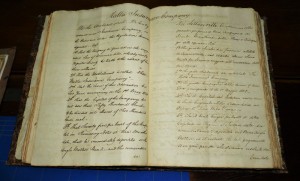 “An insurance contract which was concluded on 4 April 1536 stated that the insurance policy covered a shipment of 18 cantari of spun cotton that was going to be loaded from Birgu and shipped to Licata on the fusta of Giacomo Bonnichi. This fusta was to be captained by Paolo Xuejl or by any other captain appointed in his stead, and was secured to travel to any port which may have been deemed necessary for the purpose of the expedition.”
“An insurance contract which was concluded on 4 April 1536 stated that the insurance policy covered a shipment of 18 cantari of spun cotton that was going to be loaded from Birgu and shipped to Licata on the fusta of Giacomo Bonnichi. This fusta was to be captained by Paolo Xuejl or by any other captain appointed in his stead, and was secured to travel to any port which may have been deemed necessary for the purpose of the expedition.”Interestingly, a clause in the above contract stated that although being insured, the captain was expected to act prudently and to behave as if he was not being offered this protection, in order not to compromise the safety of the merchandise.
“Should any damage or loss occur to the insured goods, the insurers were usually expected to pay the amount insured without any objection within four months from the incident. Yet as we can see from some documents, such as the petition that was put forward by Nob. Giacomo Bonichi against Mag. Pietro Ros and Giovanni Exatopolo in relation to a contract enrolled in the acts of notary Vincenzo Bonaventura de Bonetiis in 1560, the clients were not always satisfied with the way in which claims were met.”
Abela pointed out to a most interesting contract which referred to an insurance of a consigment of apothecary products for the Order’s Infirmary. The list of products acted almost as a showcase of those ingredients which the Hospitallers used in order to produce the required medicine for their patients.
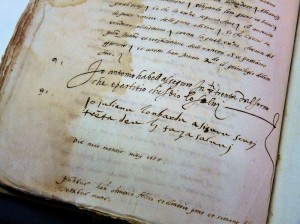 “Those who succeeded to establish themselves in this sector had to have great entrepreneurial skills since this business was still in its infancy and there were lots of risks which one had to deal with. Antonio Habell and Giuliano Lombardo were two of the earliest local entrepreneurs who besides being merchants and traders, they also offered marine insurance services, as may be noted in an insurance contract which they endorsed in respect of the safe consignment of a shipment of timber from Licata in 1558.”
“Those who succeeded to establish themselves in this sector had to have great entrepreneurial skills since this business was still in its infancy and there were lots of risks which one had to deal with. Antonio Habell and Giuliano Lombardo were two of the earliest local entrepreneurs who besides being merchants and traders, they also offered marine insurance services, as may be noted in an insurance contract which they endorsed in respect of the safe consignment of a shipment of timber from Licata in 1558.”Abela lead me to the book Trade and Port Activity in Malta 1750-1800 (2000) by John Debono where one can find detailed research related to aspects of marine insurance.
“As Debono elucidates, marine risks involved were numerous and included: inconsistency in the weather, the questionable conduct of a crew which was generally poorly and irregularly paid and usually comprised men who could not find work ashore, plundering or being taken as a slave by pirates, the unreliability of basic sea charts and portolani which only showed the depth of the water, and the perils that war brought with it.”
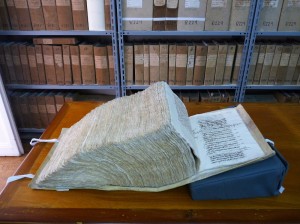 This study underlines also that initially, undewriters operated on an individual basis up to circa 1771, and those notaries which succeeded did very well financially. From an examination of insurance policies between September 1754 and August 1755 drawn up by notary Agostino Marchese, who at the time was most renowned with underwriters and insured, reveals that no less than 109 marine underwiters during that period insured a total sum of 686, 385 scudi against marine risks. However, by the 1770s individual undewriters were being replaced by insurance firms and in 1771, we see the establishment of the first insurance company in Malta.
This study underlines also that initially, undewriters operated on an individual basis up to circa 1771, and those notaries which succeeded did very well financially. From an examination of insurance policies between September 1754 and August 1755 drawn up by notary Agostino Marchese, who at the time was most renowned with underwriters and insured, reveals that no less than 109 marine underwiters during that period insured a total sum of 686, 385 scudi against marine risks. However, by the 1770s individual undewriters were being replaced by insurance firms and in 1771, we see the establishment of the first insurance company in Malta.A few years later, the Maltese Islands were in a state of turmoil as they were briefly occupied by the French and this led to a total collapse of the whole local insurance system. A new chapter in this sector initiated with the beginning of the British rule.
(This article was published in the Shipping and Logistics Supplement which was issued with the Times of Malta on 30th March 2016)
-
Take me to church
“ ‘They have hit our church!’ cried a man as he stumbled down in the tunnel which was located under the Mall Garden. We were huddling in there for shelter together with many other people as the bombs came down over Floriana,” reminisced Pawlu Piscopo who was eight at the time.
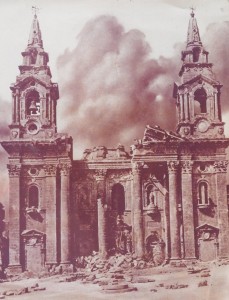 “At this horrible news, my father grabbed me and my brother by the hand and took us out of the tunnel and over to the granaries where a very sad spectacle awaited us. St Publius’ Church had suffered a direct hit. Its dome was gone and the area was surrounded in rubble. Thirteen people who were taking cover in the church’s crypt were killed and eleven more were injured. That was the blackest moment in the history of the parish church of Floriana: April 28, 1942 at 7:50am.”
“At this horrible news, my father grabbed me and my brother by the hand and took us out of the tunnel and over to the granaries where a very sad spectacle awaited us. St Publius’ Church had suffered a direct hit. Its dome was gone and the area was surrounded in rubble. Thirteen people who were taking cover in the church’s crypt were killed and eleven more were injured. That was the blackest moment in the history of the parish church of Floriana: April 28, 1942 at 7:50am.”After their house had been bombed, Pawlu’s family were allowed to take some respite in a large residence which today houses the Floriana Local Council. Yet for four years, they lived mostly underground in this tunnel which probably saved their lives. They took with them only a few belongings and the most cherished items, including a statue of St Publius which dated back to 1928 and used to adorn the model altar that his father had constructed at home.
“Most families in Malta had a model of an altar or a miniature church at home at the time. Unfortunately, many of these had to be abandoned during the war and a good number of them were destroyed when the houses were bombed.”
The craft of church model-making had been introduced to our islands by the Knights of St John back in the 16th century, and therefore its knowledge was a distinct tradition. However the adversity of war ravaged even this precious memory until eventually this craft was almost completely forgotten.
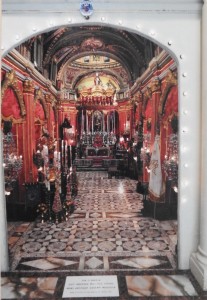 “After the war, people tried to get on with their lives as best as they could. Shops started to open again but those that used to sell miniature items with which to decorate our religious models, dwindled down to almost none. Nevertheless, the passion for model-making was much engrained in our family and when I bought a miniature structure made of four columns and a dome from a man who was leaving Malta to go to live in Australia, my father Carmelo was inspired to use it as the foundation for a model of St Publius’ church,” explained Pawlu.
“After the war, people tried to get on with their lives as best as they could. Shops started to open again but those that used to sell miniature items with which to decorate our religious models, dwindled down to almost none. Nevertheless, the passion for model-making was much engrained in our family and when I bought a miniature structure made of four columns and a dome from a man who was leaving Malta to go to live in Australia, my father Carmelo was inspired to use it as the foundation for a model of St Publius’ church,” explained Pawlu.Carmelo was a very skilled carpenter. He would go from time to time to have a look at the church and then go back to his model and construct an exact copy of the section that he had seen.
“He used the material which was handy at the time, mostly cardboard, wood and gypsum. I helped him out too in order to build the whole church which included ten altars. Eventually, this model reached a huge size of three by four metres and we could walk in it and look above at the beautiful dome,” Pawlu said proudly.
Once his father grew old, Pawlu continued with the work on this church which they had started back in the early 1960s. As he embellished this model, the wish to set up a group for model-makers in order to share this passion with them, burnt within him.
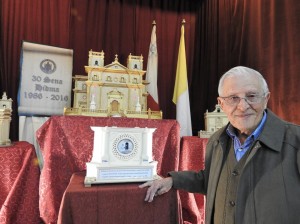 “On February 26, 1986 which happenned to be the tenth anniversary of my father’s demise, I discussed this idea with two of my friends, Raphael Micallef and Tony Terribile, who were very interested in this sector. We all agreed to do something in order to revive this craft and we sent out adverts in the newspapers to announce the set up of this group which we called Għaqda Dilettanti Mudelli ta’ Knejjes (Church Modelling Society). We were very happy when we received a great response from enthusiastic individuals all over Malta. Soon, a commitee was formed and on March 1986, we organized the first exhibition during the first two weeks of Lent wherein the members displayed the works that they had.”
“On February 26, 1986 which happenned to be the tenth anniversary of my father’s demise, I discussed this idea with two of my friends, Raphael Micallef and Tony Terribile, who were very interested in this sector. We all agreed to do something in order to revive this craft and we sent out adverts in the newspapers to announce the set up of this group which we called Għaqda Dilettanti Mudelli ta’ Knejjes (Church Modelling Society). We were very happy when we received a great response from enthusiastic individuals all over Malta. Soon, a commitee was formed and on March 1986, we organized the first exhibition during the first two weeks of Lent wherein the members displayed the works that they had.”It was certainly a great satisfaction to see this society thrive and grow along the years, always adding up new members of various ages. Today, around 400 members form part of this group which operates from its premises at 37, East Street, Valletta.
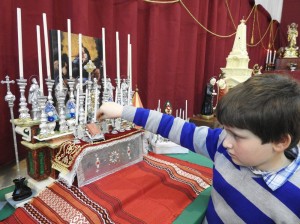 “This year we are delighted to celebrate the 30th anniversary from the establishment of this society,” Pawlu said. “The annual exhibition has been taking place each year. Besides offering the opportunity to showcase our members’ works, this event has served to help our members and the public which visits it, to meditate during the Lent period and to prepare for the Easter celebrations.”
“This year we are delighted to celebrate the 30th anniversary from the establishment of this society,” Pawlu said. “The annual exhibition has been taking place each year. Besides offering the opportunity to showcase our members’ works, this event has served to help our members and the public which visits it, to meditate during the Lent period and to prepare for the Easter celebrations.”A bi-monthly magazine, Il-Knisja Tiegħi (My Church), which was also initiated by Pawlu, is marking its 30th anniversary too. Members have been writing features in it related to different aspects of religious folklore, thereby kindling even further interest in model-making.
Once again this year, the society has organized this exhibition which saw the participation of several of its members. Exhibits varied and included small to large statues of the passion of Christ and Easter, statues of Blessed Mary and several saints, models of altars, church facades and whole churches made of different materials.
 “I hope that I’ll have enough strength to exhibit my large model of St Publius’ church,” revealed Pawlu at one point. “It takes me four weeks to set it up on a large platform and to connect the miniature chandeliers and light fittings to electricity. I am getting old now and such work is very tiring.”
“I hope that I’ll have enough strength to exhibit my large model of St Publius’ church,” revealed Pawlu at one point. “It takes me four weeks to set it up on a large platform and to connect the miniature chandeliers and light fittings to electricity. I am getting old now and such work is very tiring.”Pawlu has been exhibiting this model in a building besides the Floriana Cathecism Museum for many years now, during the feast of St Publius which takes place two weeks after Easter.
“Many people come to visit my model and they are fascinated with it. Tourists take photos besides it and they ask me how I managed to construct it section by section and yet making it look as a whole. I tell them that there are lifetimes of passion invested within it and that it is imbued with a blend of religious meaning and local traditional skills and creativity.”
At 82 years, Pawlu is serene and thankful to see the society which he has founded together with his friends strengthen itself and adding members to it.
“I just wish that it will continue to flourish for very long,” smiled Pawlu as he looked contentedly around him in order to appreciate the beautiful displayed works of the society’s members.
(This article was published in the Easter Supplement which was issued with The Times of Malta dated 21st March 2016)
-
Guests to history
One would probably spare only a few moments of consideration at the receipt of a wedding invitation. However, for Baron Igino de Piro d’Amico Inguanez, these endearing solicitations were cherished so much that he kept a collection of them, neatly separated according to their date and wrapped up together by a string.
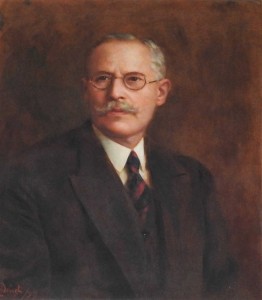 “Were it not for my grandfather’s interest to keep these wedding invitations, we would have lost this fascinating information which can be unravelled within each one of them,” remarked Marquis Nicholas de Piro as we walked towards an elegant table in one of the rooms at Casa Rocca Piccola where he had layed out a number of these invitations.
“Were it not for my grandfather’s interest to keep these wedding invitations, we would have lost this fascinating information which can be unravelled within each one of them,” remarked Marquis Nicholas de Piro as we walked towards an elegant table in one of the rooms at Casa Rocca Piccola where he had layed out a number of these invitations.I glanced out at the wide selection of wedding invitations tastefully set on the polished wooden surface, noticing the different sizes, shapes, writing, designs and paper. The earliest ones dated back to 1815, 1829 and 1832. They were quite plain and small, slightly bigger than a credit card, and written in Italian.
“Here are two of the prettiest ones” said the Marquis as he pulled them out of the rest.
These two invitations had been issued at the end of the 19th century. They were larger than the earlier ones and were quite different from each other. The one dated June 1896 was elegantly designed with an intricate cross at its corner and consisted of an invitation to the wedding between the noble Maria de Piro and Dr. Alfredo Stilon. The other one dated October 1899 was more colourful and rather than an invitation, it was more an announcement of the wedding which was to take place between the noble Maria Teresa de Piro and the Marquis Paolo Apap Bologna. Once again, both were written in Italian.
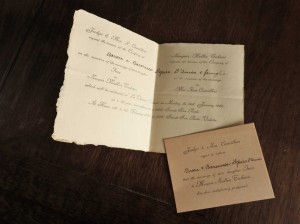 “Now look at this note which accompanies this wedding invitation,” said the Marquis as he handed it to me.
“Now look at this note which accompanies this wedding invitation,” said the Marquis as he handed it to me.The presentation of this wedding invitation was simpler than the previous two and the writing was in English. Here, Judge and Mrs L Camilleri were requesting the company of Baron and Baroness I de Piro d’Amico Inguanez and family to the wedding of their noble daughter Inez to Marquis Mallia Tabone on 26th January 1920. Yet this celebration was not destined to take place as a smaller card which was sent some days later informed those invited that this wedding had been indefinitely postponed.
 “From these invitations, one can also observe the traditional customs of the various eras. For example, this wedding invitation dated 1935 shows clearly that people who chose to get married during the period of Lent had to abide to some limitations.”
“From these invitations, one can also observe the traditional customs of the various eras. For example, this wedding invitation dated 1935 shows clearly that people who chose to get married during the period of Lent had to abide to some limitations.”Indeed, a formal note which was inserted together with the wedding invitation that was sent by Chev & Mrs E Moore and Mrs H Xuereb to announce the marriage of their daughter Alice Moore to Godfrey Xuereb, provided this information with direct instructions:
‘It is much regretted that in view of the restrictions imposed by Canon Law for weddings held in Lent, only a few guests may attend the religious ceremony at the Archbishop’s Palace.
You are therefore invited to meet the bride and bridegroom immediately after the ceremony at the residence at 4:00pm.’
 As we followed the different invitations that were sent along the years to Baron Igino and his family, we could also trace some of his friends and acquaintances, their residences, the chapels and churches where the marriages took place, and the selected locations for the wedding receptions. Although many of the churches still exist today, some of the street names had changed from Italian to English or were altered completely. A number of the residences mentioned have become quite renowned today whilst a few others were turned into commercial properties. Sadly, some of the lovely villas which provided exquisite entertainment in the bygone days were demolished to make place for large modern complexes.
As we followed the different invitations that were sent along the years to Baron Igino and his family, we could also trace some of his friends and acquaintances, their residences, the chapels and churches where the marriages took place, and the selected locations for the wedding receptions. Although many of the churches still exist today, some of the street names had changed from Italian to English or were altered completely. A number of the residences mentioned have become quite renowned today whilst a few others were turned into commercial properties. Sadly, some of the lovely villas which provided exquisite entertainment in the bygone days were demolished to make place for large modern complexes.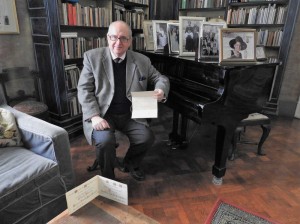 Amongst these, there was the wedding between Hilda Scicluna and Paymaster Lieutenant W Eric Brockman that took place on 4th March 1928. Their marriage was celebrated at the Archbishop’s Palace in Valletta which seems to have been quite a popular venue for such occasions. On the other hand, the reception was held at the bride’s parents residence that was located at 86 Strada Merkanti Valletta; a house which originally belonged to Sir Oliver Starkey, Bali of Aquila and Latin Secretary to Grand Master La Valette. Being an English Knight, he had assisted the Grand Master during the Great Siege of 1565 and was later given the privilege to be buried in the crypt of the Co-Cathedral of St John in Valletta, close to La Valette’s own burial place.
Amongst these, there was the wedding between Hilda Scicluna and Paymaster Lieutenant W Eric Brockman that took place on 4th March 1928. Their marriage was celebrated at the Archbishop’s Palace in Valletta which seems to have been quite a popular venue for such occasions. On the other hand, the reception was held at the bride’s parents residence that was located at 86 Strada Merkanti Valletta; a house which originally belonged to Sir Oliver Starkey, Bali of Aquila and Latin Secretary to Grand Master La Valette. Being an English Knight, he had assisted the Grand Master during the Great Siege of 1565 and was later given the privilege to be buried in the crypt of the Co-Cathedral of St John in Valletta, close to La Valette’s own burial place.The Cathedral in Mdina seems to have been another prominent place for marriages. On 24th January 1937, Adelina Maempel was married to Edwin England Sant Fournier. A reception followed at Villa Luginsland in 26 Boschetto Road, Rabat; a lovely villa which was built by Baron Max von Tucker, the German consul who was serving in Malta in the early 20th century. Unfortunately in recent years years, this remarkable place was in an abandoned state and had a haunting atmosphere.
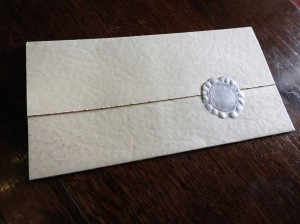 The only wedding invitation which came from Gozo looked quite distinguished and it boasted a silver wax seal. The marriage of Carmela and Paul Vella took place on 4th August 1937 and their reception was organized at the Duke of Ediburgh Hotel in Victoria, Gozo. Alas, in recent years, this splendid hotel that was beautifully constructed in Victorian architecture was demolished in order to make way for a commercial centre and a number of residential units.
The only wedding invitation which came from Gozo looked quite distinguished and it boasted a silver wax seal. The marriage of Carmela and Paul Vella took place on 4th August 1937 and their reception was organized at the Duke of Ediburgh Hotel in Victoria, Gozo. Alas, in recent years, this splendid hotel that was beautifully constructed in Victorian architecture was demolished in order to make way for a commercial centre and a number of residential units.“As you have already noted, some of these wedding invitations pertained to our relatives. Incidentally, this one which announces the marriage between my aunt Mona de Piro to Major John E J Nelson on 28th December 1940 is a favourite of mine, particularly because she was quite a character and she kept her high spirits even when she was aged more than ninety. Well, she’s there, looking at us!” the Marquis exclaimed as he pointed to a delightful portrait on the opposite wall.
My eyes met with those of a young, graceful girl, defiantly posing with an off-the-shoulder silver dress which melted in the greyish background behind her.
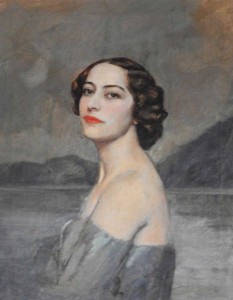 “That portrait created much talk when her relatives saw it since it was regarded too sensual at the time. It was commissioned by her Italian boyfriend, Marquis Onofrio Bartolini Salinbeni, and the painting was done by Arthur Acton who lived in a palace in Florence. Onofrio was madly in love with Mona but unfortunately, their relationship ended and when she returned to Malta, a relative of hers went to Italy to claim this painting since it was not deemed fit for him to keep it,” smiled the Marquis as he went to add some logs to the fire burning in the stylish hearth besides us.
“That portrait created much talk when her relatives saw it since it was regarded too sensual at the time. It was commissioned by her Italian boyfriend, Marquis Onofrio Bartolini Salinbeni, and the painting was done by Arthur Acton who lived in a palace in Florence. Onofrio was madly in love with Mona but unfortunately, their relationship ended and when she returned to Malta, a relative of hers went to Italy to claim this painting since it was not deemed fit for him to keep it,” smiled the Marquis as he went to add some logs to the fire burning in the stylish hearth besides us.A warm gush of air embraced the room as the logs protested and cracked and poured a glowing light over the wedding invitations lying in front of us. For a short spell, I thought that I could hear the tinkling of the glasses filled with red velvety wine and golden sizzling champagne as the guests toasted to the newly married couples.
(This article was published in the Weddings Supplement issued with The Sunday Times of Malta dated 13th March 2016)
-
Il-presepju tax-xemgħa fir-Rabat, Għawdex
 Kull meta nitla’ Għawdex u ninzerta għaddejjha minn Triq Vajringa, r-Rabat, ma nonqosx li nagħti titwila lil Toni Vassallo u lill-presepju kbir li hu ħadem mix-xemgħa.
Kull meta nitla’ Għawdex u ninzerta għaddejjha minn Triq Vajringa, r-Rabat, ma nonqosx li nagħti titwila lil Toni Vassallo u lill-presepju kbir li hu ħadem mix-xemgħa.“Meta ħriġt bil-pensjoni fl-1991, xtaqt nivvinta xi ħaġa ġdida biex ngħaddi l-ħin magħha,” stqarr Toni li llum jgħodd is-76 sena.
“Minn dejjem kont inħobb nagħmel il-presepji. Imma għodwa minnhom, ġieni f’rasi li nibda naħdem fuq presepju għal kollox differenti minn ta’ qablu. Kellu jkun presepju kbir qatiegħ u kont ser naħdmu mix-xemgħa.”
Il-kwantità kbira tax-xemgħa li kellu bżonn, Toni akkwistaha mingħand diversi ħbieb tiegħu li kienu jaħdmu fiċ-ċimiterji.
 “Kienu jġibuli l-fdalijiet tax-xemgħat u jien kont inħollhom biex ikolli l-materjal ħalli naħdem il-presepju bihom. Meta rajt li kelli ammont biżżejjed biex nibda, bdejt narma l-forma tal-presepju bil-wajer u mbagħad nimla’ bix-xemgħa fuq il-post filwaqt li nagħti l-kulur skont dak li nkun qed nibni.”
“Kienu jġibuli l-fdalijiet tax-xemgħat u jien kont inħollhom biex ikolli l-materjal ħalli naħdem il-presepju bihom. Meta rajt li kelli ammont biżżejjed biex nibda, bdejt narma l-forma tal-presepju bil-wajer u mbagħad nimla’ bix-xemgħa fuq il-post filwaqt li nagħti l-kulur skont dak li nkun qed nibni.”Fix-xenarju tal-presepju, huwa ma naqasx li jinkludi diversi aspetti konnessi m’Għawdex, fosthom għar jixbaħ lill-Għar ta’ Ninu bl-istalaktiti niżlin mis-saqaf, u galleriji, irziezet u mtieħen bi stil Għawdxi. Imbagħad huwa fassal ukoll xi figuri bħall-Madonna, San Ġużepp u l-Bambin Ġesù flimkien mar-rgħajja u persunaġġi oħra.
“Kemm ilu għandi dan il-presepju biddiltlu l-faċċata darbtejn ħalli nvarja ftit ix-xeni. Għaldaqstant ħallejt ix-xenarju li kelli fuq quddiem u ħdimt ieħor bl-istess xemgħa.”
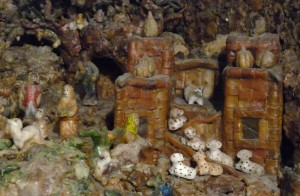 Minn ħin għall-ieħor, il-presepju jkollu xi viżitaturi u Toni ma jonqosx li jagħtihom nagħġa bajda tax-xemgħa bħala tifkira. Intant, meta erġajna sibna ruħna weħidna, hu wrieni l-apparat li bih jaħdem dawn in-nagħaġ, inkluż ukoll il-forom li jagħmel huwa stess.
Minn ħin għall-ieħor, il-presepju jkollu xi viżitaturi u Toni ma jonqosx li jagħtihom nagħġa bajda tax-xemgħa bħala tifkira. Intant, meta erġajna sibna ruħna weħidna, hu wrieni l-apparat li bih jaħdem dawn in-nagħaġ, inkluż ukoll il-forom li jagħmel huwa stess.“Issa li kbirt, dan il-presepju joffrili mezz biex nheda kemmxejn. Fl-istess ħin, fil-ftit siegħat li nkun hawn kuljum, niltaqa’ ma’ nies differenti u ngħid kelma ma’ dak u ma’ l-ieħor.”
(Dan l-artiklu deher fis-sit www.littlerock.com.mt f’Diċembru tal-2014)
Nota: Sfortunatament, illum 6 ta’ Frar 2015, ġejt mgħarrfa li Toni Vassallo żarma dan il-presepju.
-
To die for a piece of bread
Although Carnival is generally associated with fun, exuberance and colour, it was sadness, tragedy and darkness which marked this festive season on 11th February 1823, after more than a hundred children died in Valletta. Details of this terrible tragedy are immortalized in black and white in the Malta Government Gazette of Friday, 14th February 1823 which is archived at the National Library of Malta in Valletta.
Initially, news of this tragedy was recorded as a Government Notice in the Malta Government Gazette (No. 557) by Richard Plasket, Chief Secretary to Government, wherein he declared that an investigation was taking place in order to obtain any possible evidence regarding this fatal accident. A published report of these findings was later annexed as a Supplement (pp. 3391-2) to the same journal of 14th February 1823.
In this long report, Plasket includes information that was provided to him by the Archbishop of Malta, persons examined before the Magistrates of Police which comprised both relatives of the victims and other individuals who were present during this incident, and also a medical report related to this case.
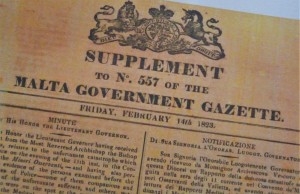 At the beginning of this statement, he furnishes a context for this mishap wherein he mentions that in those years, during the last days of the Carnival celebrations, it had become a tradition to gather a group of boys aged from 8 to 15, who came from the lower classes of Valletta and the Three Cities, to participate in a particular activity. In this event, children who opted to join were taken in a procession to Floriana or elsewhere, and after attending mass, they received some bread which was financed by the Government and other beneficiaries. The main aim of this activity was to protect the children by keeping them out of the riot and confusion of the Carnival that took place in the streets of these cities. The arrangement of this procession was under the responsibility of the Ecclesiastical Directors who taught Cathecism.
At the beginning of this statement, he furnishes a context for this mishap wherein he mentions that in those years, during the last days of the Carnival celebrations, it had become a tradition to gather a group of boys aged from 8 to 15, who came from the lower classes of Valletta and the Three Cities, to participate in a particular activity. In this event, children who opted to join were taken in a procession to Floriana or elsewhere, and after attending mass, they received some bread which was financed by the Government and other beneficiaries. The main aim of this activity was to protect the children by keeping them out of the riot and confusion of the Carnival that took place in the streets of these cities. The arrangement of this procession was under the responsibility of the Ecclesiastical Directors who taught Cathecism.Indeed, according to this tradition, on the 10th February 1823, some children were taken to attend mass at Floriana and were then accompanied to the Convent of the Minori Osservanti in Valletta (today known as the Convent of the Franciscans of St Mary of Jesus or Ta’ Ġieżu) where they were given bread without any difficulty or trouble. The same ritual was intended to take place the day after. Yet no one had any idea that a series of errors would eventually lead to such a great tragedy.
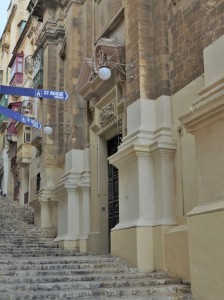 Everything started according to plan on 11th February 1823. The children were gathered in a group and were taken to mass at Floriana. However, when the ceremony lasted an hour longer than usual, the children’s procession to the Convent in Valletta coincided with the end of the Carnival celebrations, when a great number of jubilant people were returning home. This led to the next blunder, as a number of adults and children who were passing by and who knew of this tradition, secretely mixed in with the other boys in order to share the bread which would be distributed.
Everything started according to plan on 11th February 1823. The children were gathered in a group and were taken to mass at Floriana. However, when the ceremony lasted an hour longer than usual, the children’s procession to the Convent in Valletta coincided with the end of the Carnival celebrations, when a great number of jubilant people were returning home. This led to the next blunder, as a number of adults and children who were passing by and who knew of this tradition, secretely mixed in with the other boys in order to share the bread which would be distributed.In line with the usual arrangement, these boys were to enter into a corridor of the Convent from the door of the vestry of the Church, and were to be let out through the opposite door of the Convent in St Ursula Street, where the bread was to be distributed. In order to prevent the boys who received their share from reentering to take a second helping of bread, it became customary to lock the door of the vestry. Yet this time, since the children were late, this door was left open for a longer time so that they could enter. As the sun was setting and darkness crept in, nobody realized that other men and boys who did not form part of the original group were entering too.
Soon, the boys who were queuing in the corridor found themselves being pushed by these trespassers as they forced themselves in. The situation worsened when eventually the vestry door was closed as usual and the children were shoved further at the end of the corridor where a door stood half open so that no one could get back in a second time.
That day was certainly ill-fated when further mistakes continued to occur. In fact, a lamp which was usually lit in the corridor was somehow put out, leaving the overcrowded area in total darkness. This confused the people even more and as they tried to push themselves forward in order to get out, the boys who were at the front fell down a flight of eight steps on top of each other, thereby blocking further the door which happenned to open inwards.
Suddenly, both those who were distributing the bread and the Convent’s neighbours began to hear children shrieking out. They ran to give their assistance but a lot of time was wasted as they tried to open the two doors which led to the corridor in order to reach the people inside.
Eventually, many children were taken out fainting but recovered soon. Others appeared lifeless but were brought to their senses some time afterwards. Regretfully, 110 boys from 8 to 15 years of age perished from suffocation when they were pressed together in such a small place or because they were trampled upon.
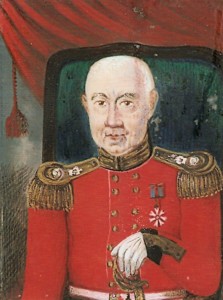 After investigating this accident, the Lieutenant Governor concluded that this was an unfortunate accident caused by the succession of errors mentioned above. Consequently, no one was accused for the death of these children since these acts were not done on purpose to harm them. In fact, Plasket commented that everyone had collaborated to assist these poor boys and even the victims’ relatives had allowed the police and the soldiers to work speedily and diligently in order to save as many children as possible. He insisted that were it not for this, the tragedy could have been much worse.
After investigating this accident, the Lieutenant Governor concluded that this was an unfortunate accident caused by the succession of errors mentioned above. Consequently, no one was accused for the death of these children since these acts were not done on purpose to harm them. In fact, Plasket commented that everyone had collaborated to assist these poor boys and even the victims’ relatives had allowed the police and the soldiers to work speedily and diligently in order to save as many children as possible. He insisted that were it not for this, the tragedy could have been much worse.As I followed further this narrative by focusing on the names mentioned in Plasket’s report, I succeeded to trace the Captain of the Malta Fencibles who led the soldiers during this tragic moment. It was his descendant, Marquis Nicholas De Piro who led me to see Colonel Marquis Giuseppe De Piro’s portrait which is located at Casa Rocca Piccola in Valletta.
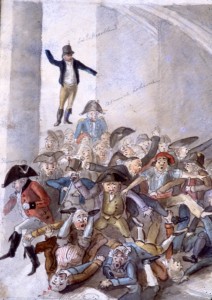 An interesting discussion ensued between us during which the present Marquis informed me also about General Sir George Whitmore who headed the Royal Engineers’ detachment on Malta as its Colonel Commandant between 1811 and 1829. Whitmore had written about his experiences in Malta and had also produced some illustrations related to our islands. Interestingly, Marquis Nicholas De Piro was in possession of a copy of one of these ancient illustrations in the form of a very small slide, which showed some individuals being trampled upon by a group of other people. He wondered whether this slide could be portraying this misfortunate accident of the Carnival of 1823. Yet no children are included in this representation and so it is not clear whether it actually depicts this narrative.
An interesting discussion ensued between us during which the present Marquis informed me also about General Sir George Whitmore who headed the Royal Engineers’ detachment on Malta as its Colonel Commandant between 1811 and 1829. Whitmore had written about his experiences in Malta and had also produced some illustrations related to our islands. Interestingly, Marquis Nicholas De Piro was in possession of a copy of one of these ancient illustrations in the form of a very small slide, which showed some individuals being trampled upon by a group of other people. He wondered whether this slide could be portraying this misfortunate accident of the Carnival of 1823. Yet no children are included in this representation and so it is not clear whether it actually depicts this narrative.My research ended at Ta’ Ġieżu Church and I watched in silence the area where these children lost their lives. Sadness engulfed me when I climbed up the steps on my way back while pondering how these children could end in this way for a piece of bread.
(This article was published in the Carnival Supplement issued with the Times of Malta dated 3rd February 2016)
-
East meets West
For many Western societies, the idea of health is the absence of disease.Yet this is not the case in China, where the aspect of health embodies a comprehensive system that focuses on a balanced lifestyle which is in harmony with nature. Evolving along thousands of years of experimentation and studies about health and longevity, the philosophy of traditional Chinese medicine is today imbued with an ancient wisdom that aims to heal and regenerate not only the body but also the mind and soul.
From 1994, this ideology is being fostered locally by means of The Mediterranean Regional Centre for Traditional Chinese Medicine which is located in Kordin, Paola. Run by a Chinese medical team which changes every two years, this centre has been regularly registering a remarkable increase in Maltese people who attend to receive treatment.
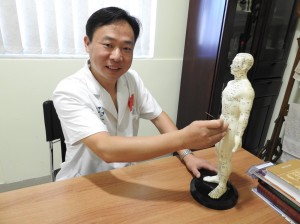 “We are very satisfied with the Maltese people’s response to our services,” remarked Dr Xu Jinhua, the present director of the centre. “In fact, last week, we treated 100 patients.”
“We are very satisfied with the Maltese people’s response to our services,” remarked Dr Xu Jinhua, the present director of the centre. “In fact, last week, we treated 100 patients.”Dr Xu is no new face in this centre since this is the second time that he has joined the Chinese medical team to work in Malta. He was here four years ago and yet he had to undergo again an eight-month preparation programme in Nanjing before coming to our country.
His interpreter, Xiaoyan Sun, described how the team of four Chinese doctors, a chef and herself were required to attend to this outward training in order to be able to provide the best service in Malta.
 “Apart from physical training, our preparation was concentrated on strengthening our ability to communicate in English and learning basic details about Maltese culture and religion. Moreover, all members of the group were familiarized with some general fundamental knowhow to enable us collaborate better. This included learning rudimental information about traditional Chinese medicine in order to be able to co-operate with the doctors, and also getting used to cook so that we could relieve our chef from time to time. Meanwhile, we were also prohibited from visiting home in order to get adjusted to the experience of living in another country, whilst at the same time the group became more like a family.”
“Apart from physical training, our preparation was concentrated on strengthening our ability to communicate in English and learning basic details about Maltese culture and religion. Moreover, all members of the group were familiarized with some general fundamental knowhow to enable us collaborate better. This included learning rudimental information about traditional Chinese medicine in order to be able to co-operate with the doctors, and also getting used to cook so that we could relieve our chef from time to time. Meanwhile, we were also prohibited from visiting home in order to get adjusted to the experience of living in another country, whilst at the same time the group became more like a family.” Genuine dedication and commitment is the order of the day as these four Chinese doctors, who are specialized in acupuncture, provide their services at this centre in Paola, at Mater Dei Hospital, and at Gozo General Hospital. Additionally, as Dr Xu revealed, this team was sent with a further task to set up a Chinese clinic at St Luke’s hospital.
Genuine dedication and commitment is the order of the day as these four Chinese doctors, who are specialized in acupuncture, provide their services at this centre in Paola, at Mater Dei Hospital, and at Gozo General Hospital. Additionally, as Dr Xu revealed, this team was sent with a further task to set up a Chinese clinic at St Luke’s hospital.Diagnosis of traditional Chinese medicine practitioners vary considerably from that of Western doctors.
“From our first glance at the patient, we get a good indication of what the client might be suffering from,” explained Dr Xu. “Immediate tell tale signs are evident in the way one walks, in one’s facial expression and posture, in the colour of the skin, and whether one is thin or fat. Furthermore, a person’s vitality shows through the brightness of the eyes, the colour of the lips, and the state of the hair.”
 It was interesting to discover that much information is also obtained by looking closely at a person’s tongue since its colour, shape and coating reflects the condition of the internal organs.
It was interesting to discover that much information is also obtained by looking closely at a person’s tongue since its colour, shape and coating reflects the condition of the internal organs.“Our investigation includes also auscultation which is done by listening to the patients’ voice, sounds of breathing, and coughing. In the old days, the diagnosis concerned also olfaction; that is smelling the odour of the patient. However today this is somewhat difficult since people use many perfumes and this hides the personal odour of individuals.”
Even pulse-taking is different since the Chinese physician uses three fingers: the index finger to check the heart and lungs, the middle finger to listen to the liver, and the ring finger to test the kidney.
“During this time, the doctor also discusses with the patient about his lifestyle, his diet, whether he practices some form of exercise and if he has any stressful atmosphere at home or at work. This practice takes place in order to see whether the patient is suffering from any sort of imbalance which is resulting in pain. For the treatment to be effective, it is very important that a good relationship is created between the patient and the doctor.”
 Along these twenty-one years, the treatments at this clinic were mainly focused on acupuncture and massage. Yet this year, Dr Xu is keen to introduce a further specialized treatment which involves the use of traditional Chinese herbs.
Along these twenty-one years, the treatments at this clinic were mainly focused on acupuncture and massage. Yet this year, Dr Xu is keen to introduce a further specialized treatment which involves the use of traditional Chinese herbs.“Chinese herbs are used widely in China. There is a vast selection of these herbs, and all have their own particular characteristics and qualities. Their utilization could offer various benefits to the Maltese people. However, till now, we are prohibited from importing these herbs to Malta to treat the locals with them.”
Probably, this restriction is due to the fact that these herbs are alien to our Western doctors. Nonetheless, possibly the time has come to make a change.
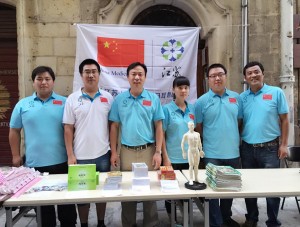 “Last year, I had the opportunity to meet Dr Konrad Mizzi, Minister for Energy and Health, whilst he was visiting some medicine colleges and hospitals in China. At the time, I was glad to see that he seemed very interested in these traditional Chinese herbs, particularly those relating to treat infertility.”
“Last year, I had the opportunity to meet Dr Konrad Mizzi, Minister for Energy and Health, whilst he was visiting some medicine colleges and hospitals in China. At the time, I was glad to see that he seemed very interested in these traditional Chinese herbs, particularly those relating to treat infertility.”“Should treatment with these herbs be allowed in Malta, a Chinese doctor specialised in this sector would be able to attend regularly in our centre in order to diagnose patients and provide treatment. I am aware that presently some people in Malta are using IVF treatment to tackle this issue. Yet in those cases where a couple does not have any problems with the organs themselves, traditional Chinese herbs might offer a less expensive and more reliable natural solution. I must say that in China we have a 70 to 80 per cent success rate for cases of infertility in such situations.”
Dr Xu pointed out that other countries, such as America, have now introduced these methods and they are having very satisfactory results. That is why he is looking very much forward to meet Dr Mizzi in order to discuss further this opportunity.
“If this treatment is made available in Malta, I am sure that many people will benefit from it. Maybe at first, people might be wary or doubtful whether a herb will really be effective. Nonetheless, once people will start obtaining positive results, others will surely follow, and we would be doing a great service to this country.”
(This article was published in ‘Fitness, Nutrition and Well-Being’ Supplement issued with The Times of Malta dated 27th January 2016)
-
WALKING WITH THE DEAD
“As soon as they saw us approaching with our horses, some shop owners hurried to close their doors in order to show us that we were not welcome,” remembered 74 year old, Alfred Mifsud. “This happenned mostly in the villages of Ħal-Kirkop and Safi, and in other areas of northern Malta. It was more a reaction to the sense of disgust which people felt towards our job rather than because of any superstitious fear that we could attract death to their doorstep. In fact, those who did let us in their shops to drink a cup of tea, had a number of reserved cups for us, since other clients would refuse to use them.”
In the old days, it was hard to be an undertaker. Work started from the early hours, when it was still dark, as it took long to prepare the horses and the carriages, and then to drive to church. The deceased was placed in a coffin and was generally carried on the shoulder, from his house to the chapel or church where mass was celebrated in the early morning, so that those who attended, could go to work soon after. In the meantime, the undertakers would stay outside, waiting to carry the coffin to the cemetery.
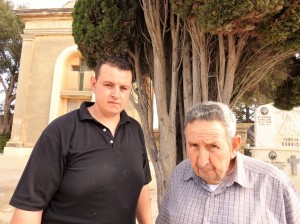 “By that time, after travelling the long road on a hard seat in the cold, we would be yearning for a cup of tea. Yet there were moments when where it not for the kindness of the church’s sacristan, we would be bound to wait for hours before we could drink something warm.”
“By that time, after travelling the long road on a hard seat in the cold, we would be yearning for a cup of tea. Yet there were moments when where it not for the kindness of the church’s sacristan, we would be bound to wait for hours before we could drink something warm.”Certainly, this was a minor discomfort when considering what the rest of the job entailed.
“People might think that undertakers will eventually get used to death and will become numb to the pain which it brings with it. However, they are definitely mistaken because we are often saddened by the suffering, especially when children are somehow involved. How can you remain indifferent when you see parents burying their child or when you hear the cry of the young ones when they see their mum or dad being hauled underground?”
A shudder ran through me and I wondered how anyone could withstand to do such a job.
“You learn to accept death as part of the circumstances of life and consider your job just like any other. You do your duty as best as you can in order to see that everything will run smoothly and that your client is served well.”
When Alfred was twelve years old, he was already assisting his dad, who was also an undertaker, to prepare the deceased for burial. He also gave a hand to other undertakers by helping them out in cemeteries. Even as a child, this work did not upset him and he was never afraid of dead people or burial grounds.
“Our family has been doing this work for more than a century now. It was Lukardu Pace, my father’s uncle, who started a career in this sector, by carrying the dead in funeral carriages. After he died in a traffic accident, my father Fidiel, who is now 93 years old, took over this job, and he introduced us in this work. Eventually it was only me who became a funeral carriage driver besides being an undertaker. However my brothers opened another business which is related to funerals.”
As Alfred began to show me some old photographs of the different funeral carriages that were available at the time, I realized that although death does not differentiate between the rich and the poor, nonetheless, affluent persons still insisted to distinguish themselves from others until the very end.
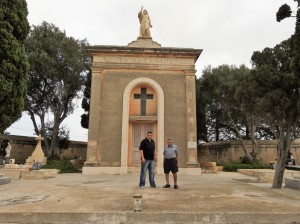 “Prosperous families used the carriage known as ‘tal-prima’ which was very elaborate and richly designed with golden sculpture. It was made of mahogany and it was drawn by four black horses that were adorned with feathers and an elegant pall. Then there was ‘tas-sekonda’ carriage which was made of cheaper painted wood and was accompanied by two black horses. A carriage painted in white and decorated with flowers was utilized to carry dead children and teenagers. In this case, the black horses were dressed with a white pall which was embellished with golden embroidery. ”
“Prosperous families used the carriage known as ‘tal-prima’ which was very elaborate and richly designed with golden sculpture. It was made of mahogany and it was drawn by four black horses that were adorned with feathers and an elegant pall. Then there was ‘tas-sekonda’ carriage which was made of cheaper painted wood and was accompanied by two black horses. A carriage painted in white and decorated with flowers was utilized to carry dead children and teenagers. In this case, the black horses were dressed with a white pall which was embellished with golden embroidery. ”Alas, there was no pomposity reserved for the destitute ones, especially if they had no family. The same thing applied to those who were in trouble with the Church.
“In the past, the Church had a much greater influence on the Maltese society. One was expected to receive the holy communion at least once a year, and a ticket known as ‘bulettin’ was given to those who adhered to this regulation. Those who did not, were not considered as part of the Church, and if they died, they became known as ‘ta’ bla preċett’. No priest would accompany them for their burial, and obviously, no mass would be celebrated. They would simply be carried away in a carriage and were buried in a particular section in the cemetery which was reserved for such people. I remember my father narrating how in such cases, the families of the deceased would insist with him to go and collect the dead relative during the night so that the neighbours will not see what was happenning. Then he would go and wait behind the cemetry’s door in order to be the first to enter once it opens, and hasten the burial before other people are around.”
Alfred remarked that the tradition to celebrate a funeral mass started from the 1970s. Before that period, the family would only organize a short function prior to the burial. In fact, during this time, he used to manage to attend to three or four burials in a day. This was not anymore possible, once funerals included also a longer mass.
“Along my 50-year career, I have witnessed many changes with regards to funerals. Amongst these, I remember many instances where the deceased was accompanied not only by family and friends, but also by members of a religious confraternity. There were also those who paid nuns and orphans from convents of charity in order to attend to their funerals.”
Interesting information kept pouring out as Alfred recalled his long experience in this work. Although happily married to Mary, he still reminisces the difficulty in his youth to find a partner, as many girls considered his work repulsive. Many years have passed from then on and the situation has somehow mitigated. However, Albert, his 29 year old son, who has followed his father’s career, told me that he had the same problem too.
 “I have been fascinated by my father’s work since I was five. Somehow, I was never afraid to help him out in cemeteries and I preferred to be with him than to go to school. Yet, I can understand the discomfort that other people who are not involved in this sector might feel in these circumstances.”
“I have been fascinated by my father’s work since I was five. Somehow, I was never afraid to help him out in cemeteries and I preferred to be with him than to go to school. Yet, I can understand the discomfort that other people who are not involved in this sector might feel in these circumstances.”“By now, I have learnt to take everything in stride, even when I notice some people making superstitious signs at me or at our hearses. There are moments when people make it embarassingly evident that they are uncomfortable with my presence. I remember clearly a particular instance when a person was so perturbed when he saw me waiting behind him in a queue, that he refused to take the rest of the money from the salesgirl and ran out of the shop.”
Just like his father, Albert admitted that when death is always on the order of the day, this job could engulf you with turmoil. Yet throughout these years, he was diligently coached by his father in order to learn how to protect himself from excessive grief, particularly by recognizing the significance of his work in alleviating this burden from the mourning family. Nevertheless, the fear of death is difficult to overcome, even when one faces it so many times.
“Instead of helping you to take death lightly, probably this work might make you perceive the end in a more dreadful way, since you know clearly what awaits you,” Albert said as he smiled nervously.
(This article was published in ‘Man Matters’ Supplement issued with The Times of Malta dated 19th December 2015)
Travelogue
Archives
| M | T | W | T | F | S | S |
|---|---|---|---|---|---|---|
| « Jan | ||||||
| 1 | 2 | 3 | 4 | 5 | 6 | 7 |
| 8 | 9 | 10 | 11 | 12 | 13 | 14 |
| 15 | 16 | 17 | 18 | 19 | 20 | 21 |
| 22 | 23 | 24 | 25 | 26 | 27 | 28 |
| 29 | 30 | |||||
Recent Posts
- A MATTER OF FATE
- MALTA’S PREHISTORIC TREASURES
- THE MAGIC IS IN THE DETAIL
- THE SELLING GAME
- NEVER FORGOTTEN
- Ġrajjiet mhux mitmuma – 35 sena mit-Traġedja tal-Patrol Boat C23
- AN UNEXPECTED VISIT
- THE SISTERS OF THE CRIB
Comments
- Pauline Harkins on Novella – Li kieku stajt!
- admin on IL-KARNIVAL TRAĠIKU TAL-1823
- Albert on IL-KARNIVAL TRAĠIKU TAL-1823
- Martin Ratcliffe on Love in the time of war
- admin on 24 SENA ILU: IT-TRAĠEDJA TAL-PATROL BOAT C23